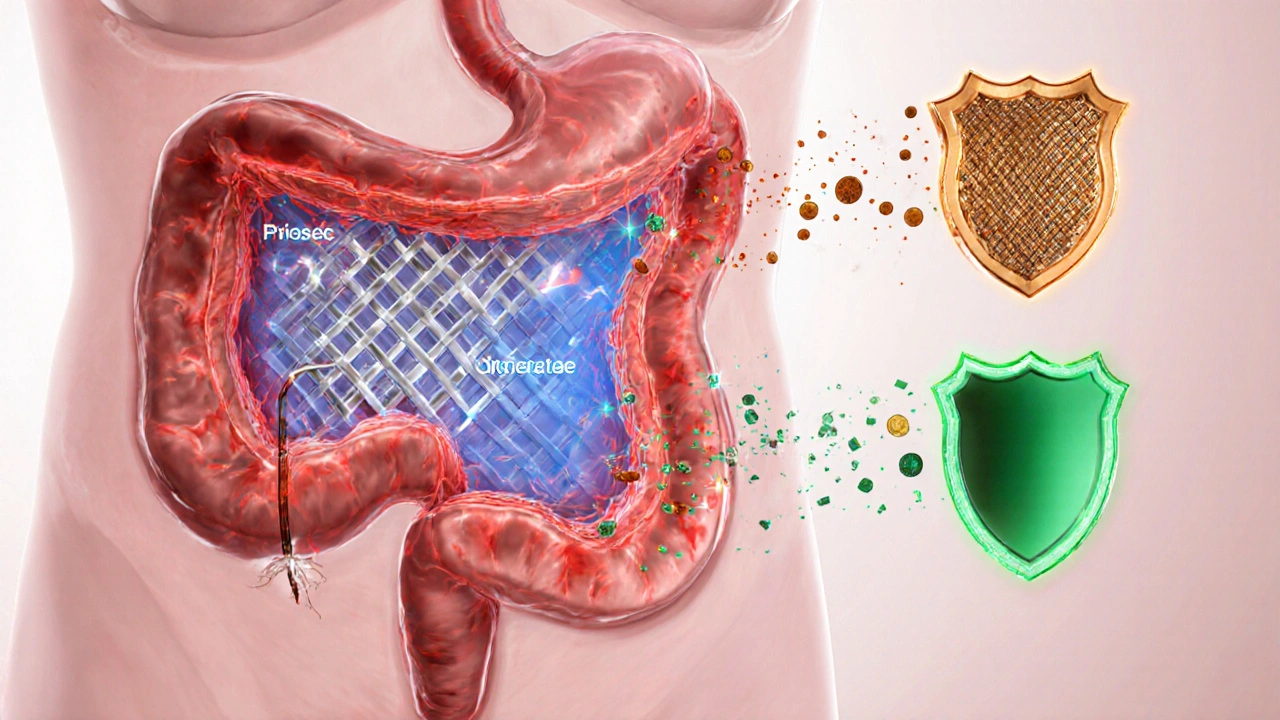Acid Reflux Medication Selector
Answer the questions below to get a personalized recommendation for acid reflux medication.
If you’ve ever reached for a bottle of Prilosec and wondered whether there’s a better fit for your heartburn, you’re not alone. Acid reflux meds come in a bewildering array of brand names, doses, and mechanisms. This guide breaks down the most common alternatives, compares key factors like speed, safety, and price, and helps you pick the right one for your daily life.
Quick Take
- Prilosec (omeprazole) is a solid, inexpensive PPI for daily use.
- Nexium (esomeprazole) offers a slightly longer half‑life, useful for night‑time reflux.
- Prevacid (lansoprazole) works fast and is available both prescription and OTC.
- Protonix (pantoprazole) is gentler on the gut, often chosen for long‑term therapy.
- H2 blockers like Pepcid (famotidine) act quicker but may need multiple daily doses.
What is Prilosec (Omeprazole)?
Prilosec is a proton pump inhibitor (PPI) that reduces stomach acid production by blocking the H+/K+ ATPase enzyme in gastric parietal cells. First approved in 1998, it quickly became a go‑to for both occasional heartburn and chronic gastro‑esophageal reflux disease (GERD). Typical over‑the‑counter dosage is 20mg once daily before breakfast, with prescription strengths reaching 40mg.
How Do the Alternatives Differ?
All acid‑reducing drugs fall into two families: PPIs and H2 blockers. PPIs provide the strongest, longest‑lasting suppression, while H2 blockers act faster but for a shorter window.
Key Comparison Criteria
- Mechanism - PPI vs. H2 blocker.
- Onset of relief - minutes (H2) vs. days (PPI).
- OTC availability - which brands you can buy without a script.
- Typical dose & frequency.
- Common side effects - risk of nutrient malabsorption, headache, etc.
- Cost per month - retail vs. generic pricing.
- Drug‑drug interactions - especially with blood thinners, antiretrovirals, or antacids.

Side‑by‑Side Comparison Table
| Brand (Generic) | Class | Typical OTC Dose | Onset of Relief | Common Side Effects | Average Monthly Cost (UK) |
|---|---|---|---|---|---|
| Prilosec (Omeprazole) | PPI | 20mg once daily | 2-3 days | Headache, abdominal pain, risk of B12 deficiency with long‑term use | £4-£6 |
| Nexium (Esomeprazole) | PPI | 20mg once daily | 2-3 days (slightly longer half‑life) | Diarrhoea, nausea, possible increased infection risk | £7-£9 |
| Prevacid (Lansoprazole) | PPI | 15mg once daily | 24‑48h | Dizziness, constipation, rare liver enzyme changes | £5-£7 |
| Protonix (Pantoprazole) | PPI | 20mg once daily (prescription) | 2-3 days | Headache, mild rash, low interaction profile | £9-£12 |
| Pepcid (Famotidine) | H2 blocker | 20mg twice daily | 30‑60min | Upset stomach, dizziness, rare confusion in elderly | £3-£5 |
| Zantac (Ranitidine) | H2 blocker | 150mg twice daily | 30‑60min | Headache, constipation, NDMA impurity concerns (withdrawn in 2024) | £2-£4 |
| Tums (Calcium Carbonate) | Antacid | Chew 2‑4 tablets as needed | Minutes | Acid rebound, hypercalcaemia if overused | £1-£2 |
Deep Dive Into Each Option
Prilosec (Omeprazole)
Best for people who need once‑daily, low‑maintenance dosing and are comfortable with a few days to feel full effect. Its generic form is cheap and widely available, making it a first‑line choice for chronic GERD.
Nexium (Esomeprazole)
Offers a marginally longer half‑life, which can help those who experience nighttime symptoms that wake them up. Slightly pricier, but the extra night‑time relief may be worth it.
Prevacid (Lansoprazole)
Shows a quicker onset among PPIs-often noticeable within 24hours. Good for patients who want a balance between rapid relief and the strong acid suppression PPIs provide.
Protonix (Pantoprazole)
Has the cleanest interaction profile, so it’s often the doctor’s pick for patients on multiple meds (e.g., blood thinners or HIV drugs). It’s prescription‑only in the UK, which can add cost.
Pepcid (Famotidine)
Works in minutes, making it ideal for occasional heartburn spikes. Because the effect fades after a few hours, you may need to take it twice a day for chronic issues.
Zantac (Ranitidine) - Why it’s Gone
Ranitidine was pulled from shelves worldwide after studies linked it to NDMA, a probable carcinogen. If you still have old stock, discard it safely and switch to an approved H2 blocker.
Tums (Calcium Carbonate)
Antacids neutralise acid instantly but don’t lower production. Use them for fast, short‑term relief, not for daily GERD management.
Choosing the Right Medication for You
Think about three practical questions before you decide:
- How often do you experience symptoms? Daily sufferers usually benefit from a PPI; occasional flare‑ups are often handled well by an H2 blocker or antacid.
- Do you need night‑time control? Nexium’s longer half‑life or a twice‑daily H2 blocker can keep you comfortable while you sleep.
- Are you on other medicines? Check for CYP450 interactions-Prilosec can increase levels of certain blood thinners, while Protonix is less likely to interfere.
For most people, starting with a cheap OTC PPI like Prilosec and seeing if symptoms improve over two weeks is a sensible approach. If you need faster action, add a Pepcid dose in the afternoon.
Safety, Interactions, and Long‑Term Use
PPIs are safe for short courses, but prolonged use (over 12 months) has been linked to:
- Vitamin B12 deficiency
- Higher risk of bone fractures
- Potential gut microbiome changes that may increase infection risk
If you anticipate using a PPI long‑term, discuss periodic blood tests with your GP. H2 blockers have a cleaner long‑term safety record but may require dosing adjustments.
Cost Snapshot (UK Prices, Oct2025)
Below is a quick reference for typical monthly out‑of‑pocket costs when bought over the counter or via a standard NHS prescription:
- Prilosec (generic) - £4-£6
- Nexium (brand) - £7-£9
- Prevacid - £5-£7
- Protonix - £9-£12 (prescription)
- Pepcid - £3-£5
- Tums - £1-£2
Buying a 28‑day supply in bulk can shave a few pounds, and many pharmacies offer a discount card for repeat purchases.

Frequently Asked Questions
Can I switch from Prilosec to Nexium without a doctor?
Yes, both are OTC PPIs, but it’s smart to finish a full course of the first drug before switching. This avoids confusing side‑effect patterns and lets you judge which works better.
How long does it take for a PPI to start working?
Most PPIs need 2‑3 days of consistent dosing to reach maximum acid suppression. Some patients notice a modest reduction in heartburn after the first night, but full relief usually appears after about a week.
Are there any foods that boost the effectiveness of PPIs?
Taking a PPI 30‑60 minutes before a meal, especially a protein‑rich breakfast, helps the drug reach the parietal cells where it works best. Avoid grapefruit juice, which can interfere with metabolism of some PPIs.
Is it safe to use antacids like Tums together with a PPI?
Yes, short‑term use of antacids on top of a PPI can give instant relief while the PPI builds up. Just don’t exceed the recommended daily calcium dose, especially if you have kidney issues.
What should I do if I miss a dose of Prilosec?
Take the missed tablet as soon as you remember, unless it’s almost time for the next dose. In that case, skip the missed one and resume the regular schedule-don’t double up.
Bottom line: there’s no one‑size‑fits‑all heartburn solution. By weighing speed, cost, safety, and how your body reacts, you can pick the right tool-whether that’s a daily Prilosec, a night‑time Nexium, or a quick Pepcid hit. Always check with your GP if you plan to stay on a medication for months, and keep an eye on any new symptoms that might need a deeper look.


Comments
Quiana Huff
Hey everyone! 🚀 If you’re hunting for the ultimate reflux solution, dive into the pharmacodynamics of PPIs – we’re talking about H+/K+ ATPase inhibition, esomeprazole half‑life extensions, and chemospecificity that can dramatically shift gastric pH curves. Grab a cup of coffee (or a caffeine‑free alternative) and remember: consistency beats spontaneity when it comes to acid suppression. 💪
On September 29, 2025 AT 04:13
Richard Walker
Interesting read, especially the breakdown of cost versus efficacy. I appreciate the balanced tone, and it’s good to see both OTC and prescription routes laid out without hype. Managing reflux is a personal journey, and having these options side‑by‑side helps folks make a calmer decision.
On September 29, 2025 AT 05:03
Julien Martin
This guide is well‑structured and technically sound. The inclusion of CYP450 interaction notes is particularly helpful for anyone on polypharmacy. Keep the jargon clear and the optimism steady – patients need both accuracy and encouragement.
On September 29, 2025 AT 05:53
Lolita Rosa
My heart burns like a patriot's fury on a cold night.
On September 29, 2025 AT 06:43
Michelle Morrison
While the data presented appears comprehensive, one must remain vigilant regarding potential corporate influences that may color the narrative. Simplicity of language does not preclude depth of analysis, and I trust readers will scrutinize the sources.
On September 29, 2025 AT 07:33
Ed Norton
Thanks for the clear overview. Very useful info.
On September 29, 2025 AT 08:23
Karen Misakyan
In the grand tapestry of gastrointestinal therapeutics, one discerns a dialectic between immediate symptomatic respite and the ontological quest for mucosal homeostasis. The primacy of the proton pump inhibitor must be weighed against the epistemic humility required to acknowledge long‑term sequelae such as hypovitaminosis B12 or osteoporotic risk. Thus, the physician’s prudence lies in a calibrated equilibrium.
On September 29, 2025 AT 09:13
Amy Robbins
Wow, another glorified sales brochure for acid‑killers. If you’re so keen on “balanced pharmacology,” perhaps you’d also mention how the market drives up prices while the real issue-dietary habits-gets ignored. 🎭
On September 29, 2025 AT 10:03
Shriniwas Kumar
Namaste! The comparison nicely touches on bioavailability, which is often overlooked in Western texts. For those integrating Ayurvedic principles, the timing of the PPI relative to prāṇa‑yogic meals can influence gastric acidity and overall digestion. Consider also the role of gut microbiota modulation when opting for a low‑interaction agent like pantoprazole.
On September 29, 2025 AT 10:53
Jennifer Haupt
When we consider the therapeutic landscape for gastro‑oesophageal reflux disease, it becomes clear that a multidimensional assessment is essential. First, the frequency and severity of symptoms dictate whether an intermittent H2 blocker or a continuous PPI regimen is warranted. Second, patient comorbidities, especially those involving hepatic metabolism, influence drug selection due to CYP450 interactions. Third, cost considerations cannot be ignored; a generic omeprazole may provide comparable efficacy to branded esomeprazole at a fraction of the price. Fourth, safety profiles over long‑term use reveal risks such as vitamin B12 deficiency, hypomagnesemia, and potential bone demineralization, urging clinicians to periodically reassess the necessity of continued therapy. Fifth, lifestyle modification remains a cornerstone-weight management, dietary adjustments, and head‑of‑bed elevation can markedly reduce reliance on pharmacotherapy. Sixth, the timing of medication relative to meals is critical; administering a PPI 30‑60 minutes before breakfast maximizes acid suppression. Seventh, clinicians should educate patients about the delayed onset of PPIs, setting realistic expectations for relief. Eighth, for those experiencing nocturnal reflux, selecting agents with longer half‑lives, like esomeprazole, or employing twice‑daily dosing can improve nighttime symptom control. Ninth, drug‑drug interaction screening is paramount, especially for patients on anticoagulants, antiretrovirals, or antifungals. Tenth, when rapid relief is necessary, an antacid or H2 blocker can serve as a bridge while the PPI reaches full effect. Eleventh, monitoring strategies, such as periodic serum magnesium and B12 levels, help mitigate adverse outcomes. Twelfth, deprescribing protocols should be considered after symptom control is achieved, tapering the dose rather than abrupt cessation. Thirteenth, shared decision‑making empowers patients to weigh benefits against potential risks, fostering adherence. Fourteenth, emerging research on the gut microbiome suggests that broad‑spectrum acid suppression may alter microbial diversity, a factor that may influence future prescribing guidelines. Finally, the therapeutic journey is iterative; regular follow‑ups allow for adjustments based on evolving clinical evidence and patient preferences.
On September 29, 2025 AT 11:43
Rhiane Heslop
Really? You’d rather hype up a drug than discuss diet? It’s absurd that people ignore the simple truth: you can’t medicate every ache. The market pushes these pills like candies, and we fall for it. Stop glorifying chemicals.
On September 29, 2025 AT 12:33
Dorothy Ng
I appreciate the calm overview, Richard. The balanced presentation helps readers avoid alarm while staying informed.
On September 29, 2025 AT 13:23
Melissa H.
Is there any data on how these meds affect gut flora over years? 🤔 Curious if long‑term PPI use might predispose to infections.
On September 29, 2025 AT 14:13
Edmond Abdou
Great philosophical insight, Karen. It reminds us to weigh both immediate relief and long‑term health.
On September 29, 2025 AT 15:03
Poppy Johnston
Nice job breaking down the options, Julien. Your encouragement makes navigating these choices less intimidating.
On September 29, 2025 AT 15:53